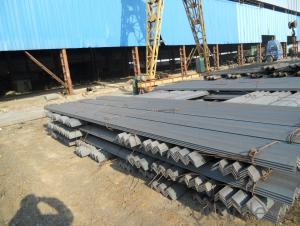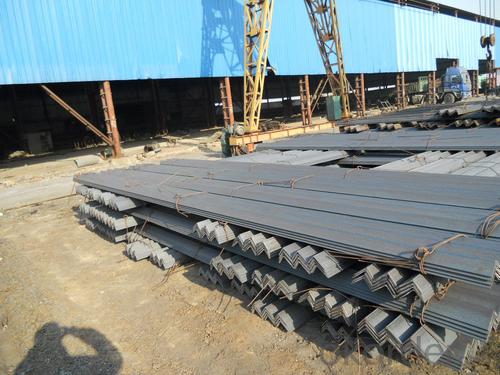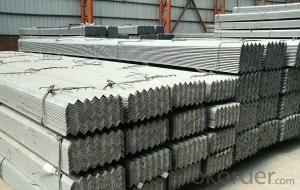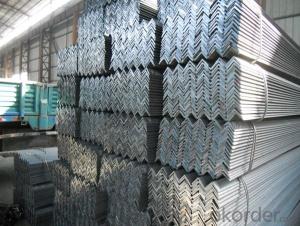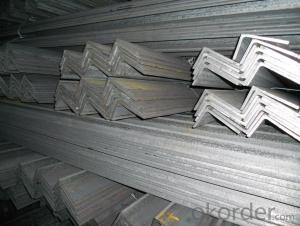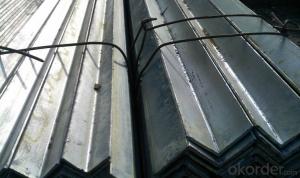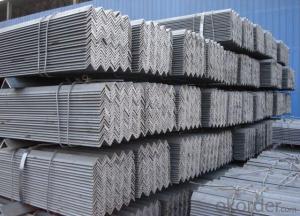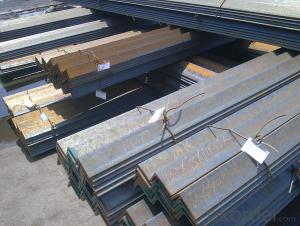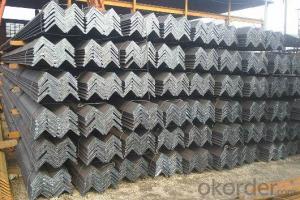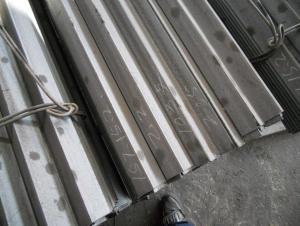Hot Rolled Steel Angle Bar Unqual Angle Bar Made In China High Quality
- Loading Port:
- Tianjin
- Payment Terms:
- TT OR LC
- Min Order Qty:
- 25 m.t.
- Supply Capability:
- 30000 m.t./month
OKorder Service Pledge
OKorder Financial Service
You Might Also Like
Specification
Product Description:
OKorder is offering Hot Rolled Steel Angle Bar Unqual Angle Bar Made In China High Quality at great prices with worldwide shipping. Our supplier is a world-class manufacturer of steel, with our products utilized the world over. OKorder annually supplies products to European, North American and Asian markets. We provide quotations within 24 hours of receiving an inquiry and guarantee competitive prices.
Product Applications:
Hot Rolled Steel Angle Bar Unqual Angle Bar Made In China High Quality are ideal for structural applications and are widely used in the construction of buildings and bridges, and the manufacturing, petrochemical, and transportation industries.
Product Advantages:
OKorder's Hot Rolled Steel Angle Bar Unqual Angle Bar Made In China High Quality are durable, strong, and resist corrosion.
Main Product Features:
· Premium quality
· Prompt delivery & seaworthy packing (30 days after receiving deposit)
· Corrosion resistance
· Can be recycled and reused
· Mill test certification
· Professional Service
· Competitive pricing
Product Specifications:
1.Standards: JIS
2.Length: 6m,9m,12m
3.Material: SS400 or Equivalent
4. Size:
Size (mm) | Mass (mm) | Size (mm) | Mass (mm) |
75*50*5.0 | 4.8 | 75*50*8.0 | 7.43 |
75*50*6.0 | 5.66 | 100*75*6.0 | 8.04 |
Packaging & Delivery of Unequal Angle Steel
1. Transportation: the goods are delivered by truck from mill to loading port, the maximum quantity can be loaded is around 40MTs by each truck. If the order quantity cannot reach the full truck loaded, the transportation cost per ton will be little higher than full load.
2. With bundles and load in 20 feet/40 feet container, or by bulk cargo, also we could do as customer's request.
3. Marks:
Color mark: There will be color marking on both end of the bundle for the cargo delivered by bulk vessel. That makes it easily to distinguish at the destination port.
Tag mark: There will be tag mark tied up on the bundles. The information usually including supplier logo and name, product name, made in China, shipping marks and other information request by the customer.
If loading by container the marking is not needed, but we will prepare it as customer request.
FAQ:
Q1: Why buy Materials & Equipment from OKorder.com?
A1: All products offered byOKorder.com are carefully selected from China's most reliable manufacturing enterprises. Through its ISO certifications, OKorder.com adheres to the highest standards and a commitment to supply chain safety and customer satisfaction.
Q2: How do we guarantee the quality of our products?
A2: We have established an advanced quality management system which conducts strict quality tests at every step, from raw materials to the final product. At the same time, we provide extensive follow-up service assurances as required.
Q3: How soon can we receive the product after purchase?
A3: Within three days of placing an order, we will begin production. The specific shipping date is dependent upon international and government factors, but is typically 7 to 10 workdays.
Q4: What makes stainless steel stainless?
A4: Stainless steel must contain at least 10.5 % chromium. It is this element that reacts with the oxygen in the air to form a complex chrome-oxide surface layer that is invisible but strong enough to prevent further oxygen from "staining" (rusting) the surface. Higher levels of chromium and the addition of other alloying elements such as nickel and molybdenum enhance this surface layer and improve the corrosion resistance of the stainless material.
Q5: Can stainless steel rust?
A5: Stainless does not "rust" as you think of regular steel rusting with a red oxide on the surface that flakes off. If you see red rust it is probably due to some iron particles that have contaminated the surface of the stainless steel and it is these iron particles that are rusting. Look at the source of the rusting and see if you can remove it from the surface.
Images:
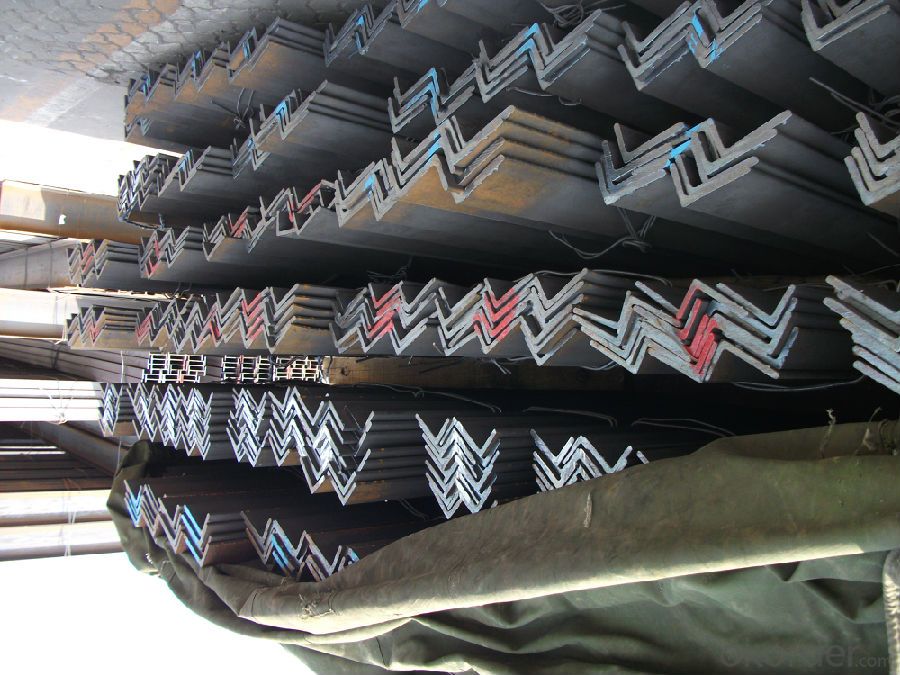
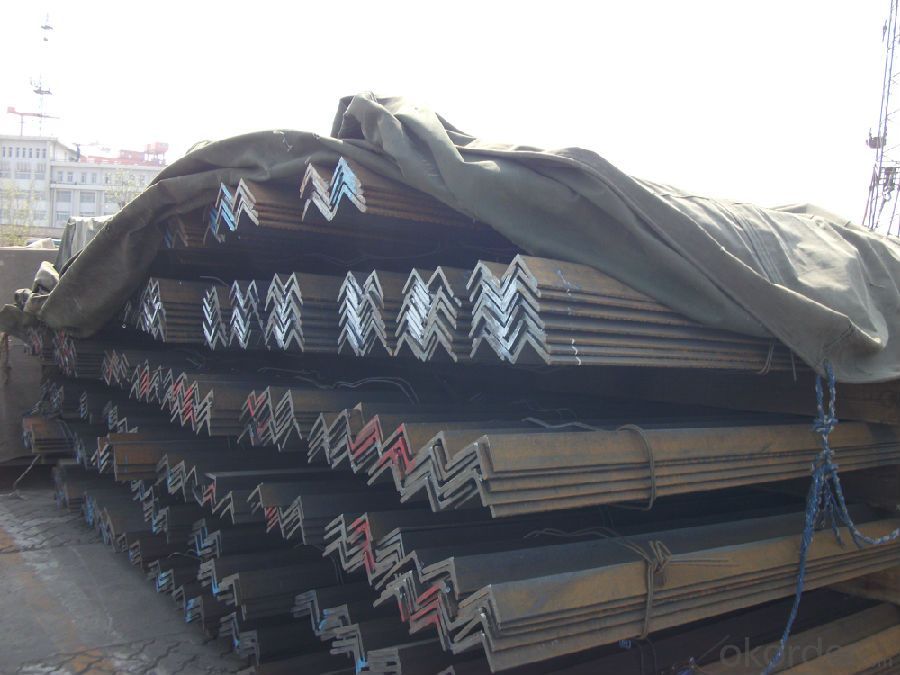
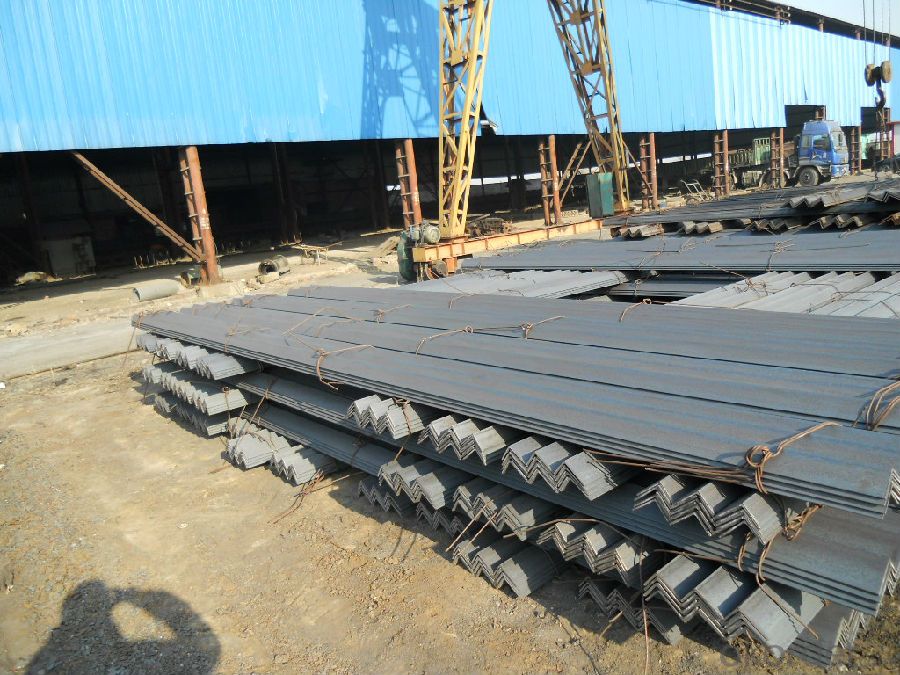
- Q: What are the considerations for selecting the appropriate steel angle finish?
- When selecting the appropriate steel angle finish, there are several considerations to keep in mind. Firstly, the intended use and environment of the steel angle should be considered. If the angle will be exposed to harsh weather conditions or corrosive substances, a finish with high resistance to corrosion, such as galvanized or stainless steel, would be suitable. Additionally, the aesthetic requirements of the project should be taken into account. Different finishes, such as powder coating or painted finishes, can provide a range of colors and textures to enhance the appearance of the steel angle. Finally, the budget and cost-effectiveness of the finish should be considered, as some finishes may be more expensive than others. Overall, it is important to select a steel angle finish that meets both the functional and aesthetic requirements of the project while being compatible with the intended environment.
- Q: What is the maximum span for a steel angle?
- The maximum span for a steel angle depends on various factors such as the size, shape, and thickness of the angle, as well as the load it is expected to bear. Generally, larger and thicker steel angles have a greater maximum span. However, it is essential to consult structural engineering standards and codes, as well as professional engineers, to determine the specific maximum span for a particular steel angle in a given application. These experts will consider factors such as the material's yield strength, deflection limits, and safety factors to provide accurate guidelines for the maximum span.
- Q: How do you determine the plastic section modulus of a steel angle?
- The plastic section modulus of a steel angle can be determined by calculating the moment of inertia of the angle about its centroid and dividing it by the distance from the centroid to the farthest fiber. This value represents the resistance of the angle to plastic bending and is crucial in analyzing its structural behavior.
- Q: How are steel angles tested for quality control?
- To ensure that steel angles meet the required standards and specifications, various testing methods are employed for quality control. Trained inspectors conduct visual inspections to detect surface defects like cracks, dents, or uneven surfaces, which could compromise the angles' structural integrity. Another method used for quality control is dimensional inspection, where measurements of length, width, and thickness are taken to ensure that the angles adhere to specified tolerances. This is crucial as deviations from the required dimensions can affect the angles' performance and fit in different applications. Mechanical testing is also conducted to assess the steel angles' mechanical properties. Tests such as tensile strength, yield strength, and elongation are performed. Tensile strength measures the maximum amount of stress the angles can bear before breaking, while yield strength indicates the stress at which permanent deformation occurs. Elongation determines the angles' ability to stretch without fracturing, providing insights into their ductility. Chemical composition analysis is another critical step in quality control. It verifies that the steel angles contain the correct proportions of alloying elements and impurities. Techniques like spectrometry are utilized to ensure compliance with the required chemical composition standards. Furthermore, non-destructive testing methods are employed to identify internal defects or inconsistencies in the steel angles without causing damage. Techniques such as ultrasonic testing, magnetic particle testing, and radiographic testing are utilized to detect potential flaws like cracks, voids, or inclusions that may not be visible to the naked eye. In summary, a combination of visual inspection, dimensional inspection, mechanical testing, chemical composition analysis, and non-destructive testing is employed to ensure the quality and integrity of steel angles. These rigorous quality control measures guarantee that the angles meet the necessary standards and can perform their intended functions safely and reliably.
- Q: What are the cost considerations for using steel angles?
- When using steel angles, there are several factors to keep in mind regarding costs. Firstly, the price of the steel material itself can vary depending on the grade and quality. Higher-grade steel angles tend to be pricier but offer better strength and durability. The overall cost is also influenced by the length and size of the steel angles. Longer and larger angles generally come at a higher price due to the increased amount of steel needed. It is important to carefully assess the required dimensions to avoid unnecessary expenses. Another cost consideration is the fabrication and finishing of the steel angles. Custom fabrication or special finishing techniques like welding, cutting, or painting can add to the total cost. It is crucial to take these additional expenses into account when budgeting for the use of steel angles. Transportation costs should not be overlooked either. Steel angles are heavy and bulky, which can result in higher shipping expenses, especially for long distances. It is essential to factor in these costs, especially for projects that require a significant quantity of steel angles. Lastly, it is important to consider the long-term costs associated with steel angles. While steel is durable and long-lasting, it may require maintenance or protective coatings to prevent corrosion over time. These maintenance costs should be included in the overall budget to ensure the longevity and reliability of the steel angles. In summary, the cost considerations for using steel angles include the price of the steel material, the dimensions and size of the angles, fabrication and finishing processes, transportation expenses, and long-term maintenance costs. Evaluating and planning for these factors will help ensure a cost-effective and successful use of steel angles in various applications.
- Q: What is the purpose of using steel angles in construction?
- The purpose of using steel angles in construction is to provide structural support and stability. Steel angles are commonly used to reinforce corners, edges, and joints, ensuring the strength and rigidity of the overall structure. They help distribute the load evenly and resist torsional forces, making them essential for the construction of beams, frames, and various structural components.
- Q: What are the different types of steel angles used in door and window frames?
- There are several types of steel angles commonly used in door and window frames, each offering unique benefits and applications. 1. L-shaped Angle: This is the most common type of steel angle used in door and window frames. It features a 90-degree angle and is typically used to provide structural support and reinforcement. L-shaped angles are versatile and can be easily welded or bolted into place, making them suitable for various frame designs. 2. T-shaped Angle: As the name suggests, T-shaped angles have a cross-section resembling the letter "T." They are often used to provide additional strength and stability to door and window frames. T-shaped angles are commonly used in heavy-duty applications where increased load-bearing capacity is required. 3. Equal Angle: Equal angles have two equal sides that form a 90-degree angle. They are commonly used in door and window frames that require equal support on both sides. These angles are suitable for applications where symmetry and balance are important, ensuring that the frame remains stable and level. 4. Unequal Angle: Unlike equal angles, unequal angles have two sides of different lengths. They are commonly used in door and window frames that require varying degrees of support on each side. Unequal angles are versatile and can be used to compensate for differences in wall thickness or other structural considerations. 5. Slotted Angle: Slotted angles are often used in door and window frames that require adjustable or modular designs. They feature a series of holes or slots along their length, allowing for easy attachment and customization. Slotted angles are commonly used in DIY projects or applications where flexibility and adjustability are desired. It is worth noting that the choice of steel angle for door and window frames depends on various factors such as the specific application, load-bearing requirements, and aesthetic considerations. Consulting with a structural engineer or a professional in the field can help determine the most suitable type of steel angle for a particular project.
- Q: What are the different types of steel angles connections?
- Construction and engineering projects utilize various steel angle connections. Some commonly used types are: 1. Welded Connection: Skilled welders join the angles using welding techniques, creating a robust and rigid connection. However, this method requires time and expertise. 2. Bolted Connection: Bolts, nuts, and washers connect the angles, allowing for easy disassembly and modification. It is popular for temporary structures or situations requiring future changes. Additional reinforcement like gussets or plates can be used. 3. Riveted Connection: In older steel structures and bridges, riveting was commonly employed. Rivets, which are metal pins with a head, are hammered into pre-drilled holes to form a permanent connection. 4. Clip Angle Connection: Clip angles, small steel angles, are bolted or welded to the main angles, providing additional support and reinforcement. This enhances the strength and stability of the primary connection. 5. Pinned Connection: Pinned connections enable rotational movement between angles, allowing for flexibility and load redistribution. A pin or bolt passes through holes in the angles, enabling free rotation. 6. Gusset Plate Connection: Gusset plates, flat steel plates, connect and reinforce the angles. They are typically bolted or welded to the angles, adding strength and stability to the connection. The selection of a steel angle connection depends on factors such as load-bearing requirements, structural design, installation ease, and future modifications. Each type has its own advantages and disadvantages, and engineers carefully choose the most suitable connection based on project-specific needs.
- Q: How do steel angles contribute to the overall strength of a structure?
- Steel angles contribute to the overall strength of a structure in several ways. First and foremost, they provide structural stability by distributing the load and forces evenly throughout the structure. The L-shape of steel angles allows them to resist bending and twisting, making them ideal for providing support and preventing deformation. Steel angles are often used as bracing elements in construction due to their high strength-to-weight ratio. By adding diagonal steel angles to a structure, it becomes more resistant to lateral forces such as wind or seismic loads. These angles help to transfer the applied forces to the foundation, reducing the risk of structural failure. Another way steel angles contribute to strength is by providing additional reinforcement. They can be strategically placed at critical points of a structure, such as corners or joints, to enhance its overall rigidity and durability. Steel angles can also be used as framing members, supporting beams, or columns, further enhancing the load-bearing capacity of the structure. Moreover, steel angles are resistant to corrosion and have a long lifespan, making them a reliable choice for structural applications. They can withstand harsh environmental conditions, ensuring the structural integrity of the building over time. Overall, steel angles play a crucial role in enhancing the strength and stability of a structure. Their ability to distribute loads, resist bending and twisting, provide reinforcement, and withstand environmental factors make them an essential component in modern construction.
- Q: Are steel angles resistant to pests or insects?
- Pests and insects pose a threat to steel angles as they lack resistance against them. Unlike treated wood and other materials, steel angles do not possess innate abilities to repel or deter pests and insects. Nevertheless, when combined with other pest control methods, steel angles can still serve as an effective solution to prevent damage caused by pests or insects. One approach is to seal off any gaps or openings surrounding the steel angles, thus preventing pests or insects from infiltrating the area. Moreover, conducting regular inspections and maintenance is crucial in promptly identifying and resolving any pest or insect-related concerns before they escalate into significant issues.
Send your message to us
Hot Rolled Steel Angle Bar Unqual Angle Bar Made In China High Quality
- Loading Port:
- Tianjin
- Payment Terms:
- TT OR LC
- Min Order Qty:
- 25 m.t.
- Supply Capability:
- 30000 m.t./month
OKorder Service Pledge
OKorder Financial Service
Similar products
Hot products
Hot Searches
Related keywords
